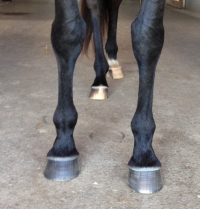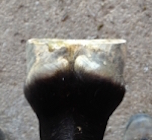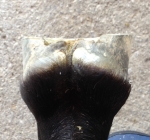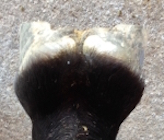These days, fewer and fewer horses reside on the racetrack grounds than there have been in the past. Tracks would stable, on site, most of the horses racing at that facility. A racetrack would normally have enough stalls to fill the weekly card and accommodate the green (unraced) horses as well.
As tracks evolve, this is falling by the wayside. More horses stable off-track for a variety of reasons. The evolution of the track facilities comes with fewer stalls.
Something that comes with fewer stalls is fewer (or no) blacksmith shops. Farriers are more frequently traveling to the horse as opposed to having that horse brought to the shop. I will admit it is of great convenience to have the shoes and equipment already set up.
The greatest value, however, is the shop itself, with a flat, uniform surface to stand the horse on and plenty of light.
The most critical component of an excellent shoeing job is assessing the horse and deciding how to trim the feet. A great job of shoe-making cannot overcome poor hoof preparation. Hoof prep evaluation is best done on a flat and uniform surface.
 (Photos by the author) Fig. 1: Farriers like to look how a horse stands before shoeing. If the ground isn't even, it's harder to make an accurate assessment of a horse's shoeing needs.
(Photos by the author) Fig. 1: Farriers like to look how a horse stands before shoeing. If the ground isn't even, it's harder to make an accurate assessment of a horse's shoeing needs.
We all like to pick up a leg, sight down that limb and decide whether the hoof is level, as shown in Figure 1. Figure 2 in this view looks pretty level. Figure 3 looks a bit high on the outside branch. (This is a left front so the outside branch is to the right.) Figure 4 looks like it is slightly low on the outside (again left front).
When we pick up a hoof for this purpose, we tend to pull it away from the horse’s center so that we can get over it ourselves and look at it. Here lies a problem. Since people are all made differently and move differently, we pick up feet to a position that is comfortable for us. Whether one is short, or tall, skinny, or fat, an individual’s comfortable position will vary.
You may have noticed that all three pictures of this view are the very same hoof, and all before any trimming was done. Obviously the way we hold a hoof doesn’t change whether it is level, only the way we see it. The thing that matters most is how the hoof interacts with the ground.
Back to Figure 1, again same horse. So if you really want to know if a hoof is level (or should be) look at on the ground. A few of the points I look for:
- Does it support the bony column of the leg above equally from side to side and front to back?
- Is the coronary band (hairline is a good reference) parallel to the ground and perpendicular to the leg?
- Are both heels of the same hoof equal height when looking from behind that hoof?

Fig. 2: The bottom of this hoof looks level.

Fig. 3: This left front hoof looks a bit high on the outside (right).

Fig. 4: This hoof looks a bit low on the outside. NOTE: These three photos are all the same hoof, just held different ways by the farrier.
These criteria may or may not be achievable, but are a few of the points that serve as a good guideline for most horses, and are best decided with a good and consistent view. Trimming and shoeing on an unlevel surface, standing in tanbark, or worse, in a dark stall make this important step many times more difficult. In some situations it is impossible.
Many training barns have a good setup for shoeing. A little extra space in the barn can facilitate the work (grooms like to get this task done as soon as possible). It will also create opportunity for better and more consistent work many time I will see something while shoemaking and alter my trim before nailing on a shoe. It will also keep the farrier out of your way while you train horses.
So with blacksmith shops becoming underutilized, the value of the shop can be reproduced in nearly any barn. So if you want to pay your farrier a nice compliment, tell him that he can “flat out” shoe a horse!
Veteran Standardbred farrier Steve Stanley of Lexington, Ky., authors a monthly column for Hoof Beats, the official harness racing publication of the U.S. Trotting Association. The American Farriers Journal Editorial Advisory Board member offers plenty of practical advice that will be of special interest regardless of the type of horses that you work with. Click here to read more from Steve Stanley's Hoof Beats series.








Post a comment
Report Abusive Comment